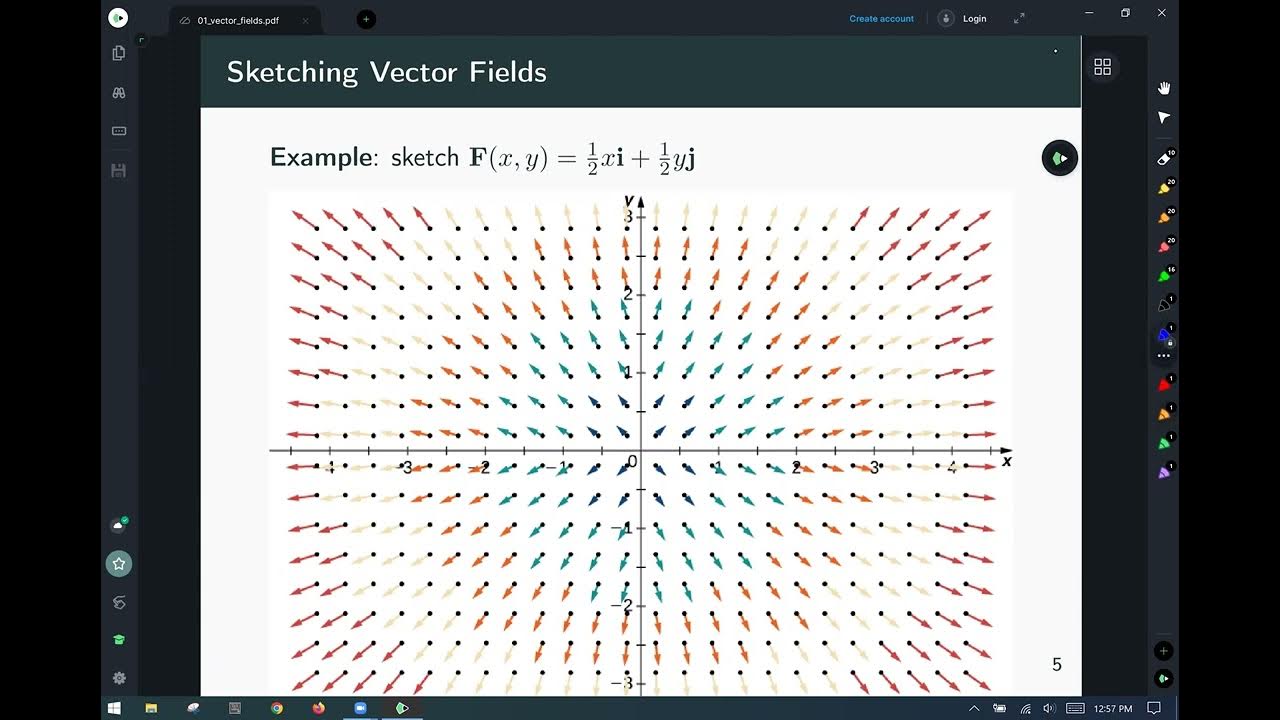TEORIA Versori e componenti cartesiane di un vettore AMALDI ZANICHELLI
Summary
TLDRThis script explains the decomposition of vectors in a plane or space, emphasizing the process of breaking a vector into two or three components along chosen directions. It describes how vectors can be projected onto axes in an orthogonal coordinate system, particularly using Cartesian coordinates (hicks and ypsilon). In this system, any vector can be uniquely identified by its components along the axes, with the use of unit vectors (versors) of length one. When extended to three-dimensional space, three components are needed to describe the vector. This approach ensures clarity in representing vectors with precise numerical values.
Takeaways
- 😀 A vector can always be decomposed along two chosen directions on a plane.
- 😀 The components of a vector are found by projecting it parallel to the lines representing the chosen directions.
- 😀 Decomposition involves finding two vectors along chosen directions whose sum equals the original vector.
- 😀 In an orthogonal reference system with Cartesian axes (x and y), a vector can be described by its components along these axes.
- 😀 The origin (0,0) is the point where the Cartesian axes meet in a 2D reference system.
- 😀 Unit vectors, also known as versors, have a length of one and align with the directions of the Cartesian axes.
- 😀 Choosing a reference system in the plane uniquely identifies each vector by two numbers representing its Cartesian components.
- 😀 Vectors in a plane are described by two components (x and y), based on the chosen Cartesian coordinate system.
- 😀 For vectors in three-dimensional space, three Cartesian components are required for description, as opposed to two in the plane.
- 😀 The decomposition of vectors into components allows for clear and precise representation in different coordinate systems.
Q & A
What is the main idea behind vector decomposition in a plane?
-Vector decomposition involves breaking down a vector into components along two arbitrarily chosen directions in a plane. The goal is to represent the vector as the sum of two smaller vectors aligned with these chosen directions.
How are the components of a vector obtained?
-The components of a vector are obtained by projecting the vector along the chosen directions, which are represented by lines in the plane.
What does the decomposition of a vector in the plane consist of?
-The decomposition consists of finding two vectors aligned with the chosen directions, such that their sum equals the original vector.
How can a vector be represented in a Cartesian coordinate system?
-In a Cartesian coordinate system with orthogonal axes, a vector can be described using its components along the x and y axes, denoted as 'a_x' and 'a_y'.
What are unit vectors and how are they used in vector decomposition?
-Unit vectors, or 'versors', are vectors with a magnitude of one. They have the same direction as the coordinate axes (x and y) and are used to express vector components in terms of their projections along these axes.
How is a vector identified once a reference frame is chosen?
-Once a reference frame is chosen, every vector in the plane can be uniquely identified by its two Cartesian components, which correspond to the projections along the x and y axes.
What happens when a vector is defined in three-dimensional space instead of a plane?
-When a vector is defined in three-dimensional space, it requires three components to describe it—one for each of the x, y, and z axes.
What is the significance of choosing an orthogonal coordinate system for vector decomposition?
-An orthogonal coordinate system simplifies vector decomposition, as the components of the vector along the axes can be clearly defined and calculated independently.
Can the direction of the components be arbitrary in vector decomposition?
-No, the direction of the components should be chosen according to the reference axes, typically aligned with the coordinate system's axes for consistency.
What is the role of the origin in vector decomposition when using Cartesian coordinates?
-The origin (0, 0) in a Cartesian coordinate system is the reference point where the axes meet, and it serves as the starting point for measuring the vector's components.
Outlines

Этот раздел доступен только подписчикам платных тарифов. Пожалуйста, перейдите на платный тариф для доступа.
Перейти на платный тарифMindmap

Этот раздел доступен только подписчикам платных тарифов. Пожалуйста, перейдите на платный тариф для доступа.
Перейти на платный тарифKeywords

Этот раздел доступен только подписчикам платных тарифов. Пожалуйста, перейдите на платный тариф для доступа.
Перейти на платный тарифHighlights

Этот раздел доступен только подписчикам платных тарифов. Пожалуйста, перейдите на платный тариф для доступа.
Перейти на платный тарифTranscripts

Этот раздел доступен только подписчикам платных тарифов. Пожалуйста, перейдите на платный тариф для доступа.
Перейти на платный тарифПосмотреть больше похожих видео

FISICA! parliamo di SCOMPOSIZIONE VETTORIALE, scomposizione vettori, scomposizione di un vettore

03 01 Fisika Dasar 1- Pengenalan Vektor

Grade 11 Sc | Ch 7: Kinematics | 7.3. Position Vector (1)

Fisika SMA - Vektor (3) - Penjumlahan Vektor Metode Jajar Genjang (I)

calc 3 vector fields

1]Vector in Plane and Space - Vector Analysis - Engineering Mathematics
5.0 / 5 (0 votes)
